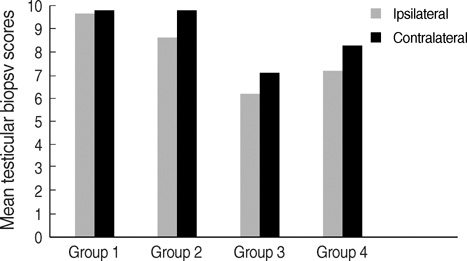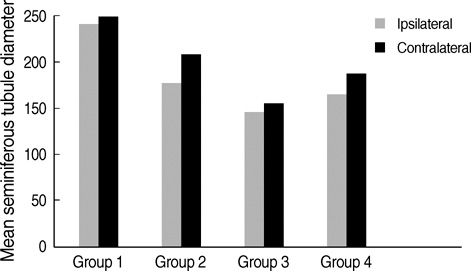J Korean Med Sci.
2009 Oct;24(5):849-852. 10.3346/jkms.2009.24.5.849.
Effects of Chemical Sympathectomy on Contralateral Testicular Histology and Fertility in Unilateral Vasectomy
- Affiliations
-
- 1Department of Urology, Akdeniz University, Faculty of Medicine, Antalya, Turkey. tkoksal@akdeniz.edu.tr
- KMID: 1782005
- DOI: http://doi.org/10.3346/jkms.2009.24.5.849
Abstract
- Unilateral obstruction or injury to the vas deferens can result in significant injury to the contralateral testicle. Although various pathways have been proposed, the mechanism of contralateral testicular deterioration remains controversial. The present animal study was performed to evaluate the effects of unilateral vasectomy on ipsilateral and contralateral testicular histology and fertility in rats that were chemically sympathectomized neonatally. The study comprised 40 male albino rats: 20 received a placebo and the other 20 underwent chemical sympathectomy neonatally. When 60 days old, each group of 20 rats was divided into two groups that underwent either a sham operation or an operation to create unilateral left vasectomy. Eight weeks after surgery, each male rat was housed with two known fertile female rats for 25 days, and then their testes were harvested. Mean seminiferous tubular diameters (MSTD) and mean testicular biopsy scores (MTBS) were determined for each testis. Although MSTD and MTBS were not significantly different between groups, chemical sympathectomy prevented the decrease in total fertility rates of the rats with unilateral left vasectomy in our study. Prevention of this decrease by chemical sympathectomy suggests that the sympathetic nervous system may play a role in the testicular degeneration associated with vasectomy.
Keyword
MeSH Terms
Figure
Reference
-
1. Andiran F, Okur DH, Kilinc A, Gedikoglu G, Kilinc K, Tanyel FC. Do experimentally induced ipsilateral testicular torsion, vas deferens obstruction, intra-abdominal testis or venous obstruction damage the contralateral testis through a common mechanism? BJU Int. 2000. 85:330–335.
Article2. West DA, Chehval MJ, Winkelmann T, Martin SA. Effect of vasovasostomy on contralateral testicular damage associated with unilateral vasectomy in mature and immature Lewis rats. Fertil Steril. 2000. 73:238–241.
Article3. Chehval MJ, Martin SA, Alexander NJ, Winkelmann T. The effect of unilateral injury to the vas deferens on the contralateral testis in immature and adult rats. J Urol. 1995. 153:1313–1315.
Article4. Matsuda T, Horii Y, Yoshida O. Unilateral obstruction of the vas deferens caused by childhood inguinal herniorrhaphy in male infertility patients. Fertil Steril. 1992. 58:609–613.
Article5. Chakraborty J, Hikim AP, Jhunjhunwala JS. Quantitative evaluation of testicular biopsies from men with unilateral torsion of spermatic cord. Urology. 1985. 25:145–150.
Article6. Dokucu AI, Ozturk H, Ozdemir E, Ketani A, Buyukbayram H, Yucesan S. The protective effects of nitric oxide on the contralateral testis in prepubertal rats with unilateral testicular torsion. BJU Int. 2000. 85:767–771.
Article7. Tanyel FC, Buyukpamukcu N, Hicsonmez A. Contralateral testicular blood flow during unilateral testicular torsion. Br J Urol. 1989. 63:522–524.
Article8. Salman AB, Mutlu S, Iskit AB, Guc MO, Mutlu M, Tanyel FC. Hemodynamic monitoring of the contralateral testis during unilateral testicular torsion describes the mechanism of damage. Eur Urol. 1998. 33:576–580.
Article9. Akgur FM, Kilinc K, Tanyel FC, Buyukpamukcu N, Hicsonmez A. Ipsilateral and contralateral testicular biochemical acute changes after unilateral testicular torsion and detorsion. Urology. 1994. 44:413–418.
Article10. Karaguzel G, Tanyel FC, Kilinc K, Buyukpamukcu N, Hicsonmez A. The preventive role of chemical sympathectomy on contralateral testicular hypoxic parameters encountered during unilateral testicular torsion. Br J Urol. 1994. 74:507–510.11. Karaguzel G, Gedikoglu G, Tanyel FC, Buyukpamukcu N, Hicsonmez A. Subsequent biological effects of chemical sympathectomy in rats undergoing unilateral testicular torsion. Eur Urol. 1995. 28:147–151.12. Oguzkurt P, Okur DH, Tanyel FC, Buyukpamukcu N, Hicsonmez A. The effects of vasodilatation and chemical sympathectomy on spermatogenesis after unilateral testicular torsion: a flow cytometric DNA analysis. Br J Urol. 1998. 82:104–108.
Article13. Coskun S, Tbakhi A, Jaroudi KA, Uzumcu M, Merdad TA, Al-Hussein KA. Flow cytometric ploidy analysis of testicular biopsies from sperm-negative wet preparations. Hum Reprod. 2002. 17:977–983.
Article14. Shandling B, Janik JS. The vulnerability of the vas deferens. J Pediatr Surg. 1981. 16:461–464.
Article15. Ciftci AO, Muftuoglu S, Cakar N, Tanyel FC. Histological evidence of decreased contralateral testicular blood flow during ipsilateral testicular torsion. Br J Urol. 1997. 80:783–786.
Article16. Zini A, Schlegel PN. Cu/Zn superoxide dismutase, catalase and glutathione peroxidase mRNA expression in the rat testis after surgical cryptorchidism and efferent duct ligation. J Urol. 1997. 158:659–663.
Article17. Free MJ, Jaffe RA. Dynamics of circulation in the testis of the conscious rat. Am J Physiol. 1972. 223:241–248.
Article18. Karnak I, Gedikoglu G, Tanyel FC, Buyukpamukcu N, Hicsonmez A. The effects of chemical sympathectomy on contralateral testicular histology, fertility and fecundity in unilateral abdominal testes. Br J Urol. 1996. 77:580–584.
Article19. Ozturk H, Tander B, Aydin A, Okumus Z, Cetinkursun S. The effects of chemical sympathectomy on testicular injury in varicocele. BJU Int. 2001. 87:232–234.20. Karnak I, Tanyel FC, Kilinc K, Buyukpamukcu N, Hicsonmez A. Tissue hypoxia in ipsilateral and contralateral testes undergoing surgically induced maldescent. Eur J Pediatr Surg. 1996. 6:281–284.
Article
- Full Text Links
- Actions
-
Cited
- CITED
-
- Close
- Share
- Similar articles
-
- Correlation Between Histological Changes of Human Testis after and Fertility after Subsequent Vasectomy Reversal Vasectomy
- Protective Effect of Capsaicin on Contralateral Testis of Rats during Unilateral Testicular Torsion
- The Effect of Testicular Torsion on the Histologic Findings and Apoptosis of the Contralateral Testis at Various Ages in Rats
- The effect of testicular torsion on the contralateral testis in rats
- Semen Analysis for Evaluation of Fertility in Untreated Unilateral Cryptorchidism



